This tropical Asian tree is squat and tortuous; it has trifoliated leaves that fall in the cool season. The beautiful, brilliant red flowers bloom at the end of bare branches, the floral bunches resembling claws, and when they open, a long tuft of stamens emerges. The branches are often covered with thorns and it is said that in Buddhist hell the sinners must climb them. In India, it is one of the five trees of Paradise which grants all wishes, its flowers are offered to the Indian gods, Shiva and Hanuman.
In Laos, the young leaves are eaten as vegetables. In traditional medicine, thong ban has hypnotic properties, it is a strong purgative, a diuretic (bark), it can fight snake bites (seeds), and it relieves painful joints (the leaves). As for the Traditional Medicine Research Centre, it recommends baths made with leaves and roots to reduce swelling.
But this tree belongs to the history of Laos. In fact, in the XIII and XIV centuries, Luang Prabang was called Xieng Dong Xieng Thong, literally translated: “Town of the Dong (a river), town of the Flame Tree”. But, to us, this translation seems somewhat incorrect, because the actual name of the Flame tree is fang, also because the Flame Tree is a tree from Madagascar and it is quite unlikely that it was introduced to Laos before the XIII century. The flamboyance of the Tiger Claw Tree (and that of ton tiane, Butea manosperma, with which it is sometimes confused) no doubt explains this error.
Cet arbre d’Asie tropicale est trapu et tortueux; il a des feuilles trifoliées qui tombent à la saison fraîche. Les fleurs sortent en bout des branches dénudées et sont d’un beau rouge brillant, les boutons floraux ressemblent à des griffes et laissent échapper en s’ouvrant une longue touffe d’étamines. Les branches sont souvent couvertes d’épines et l’on dit que dans l’enfer bouddhique les pêcheurs doivent y monter. En Inde, il est l’un des cinq arbres du paradis, celui qui exauce tous les vœux, ses fleurs sont offertes à Shiva aussi bien qu’à Hanuman.
Au Laos les jeunes feuilles sont consommées comme légumes. En médecine traditionnelle thong ban a des propriété hypnotique, purgative énergique, diurétique (écorce), il peut combattre les morsures de serpents (graines), il soulage les douleurs articulaires (feuilles). L’IMT, quant à lui, recommande des bains de feuilles et de racines pour résorber les enflures.
Mais cet arbre appartient à l’histoire du Laos. En effet Louang Prabang s’est appelée aux XIII° et XIV° siècles Xieng Dong Xieng Thong, traduit unanimement par « ville du Dong (une rivière) ville du flamboyant »; or cette traduction nous semble incorrecte d’une part parce que le nom actuel du flamboyant est fang, d’autre part parce que le flamboyant est un arbre de Madagascar et qu’il est peu probable qu’il ait déjà été introduit au Laos au XIII° siècle. La « flamboyance » de la floraison de cet arbre (et de celle de ton tiane, Butea manosperma, avec lequel il est parfois confondu) explique sans doute cette erreur.
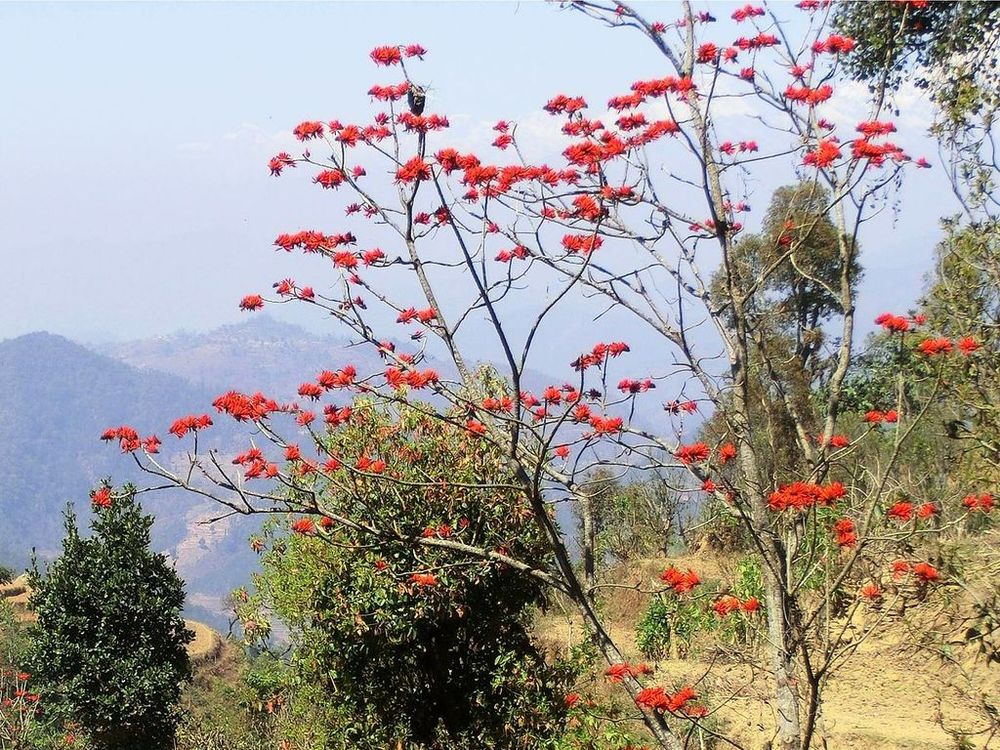
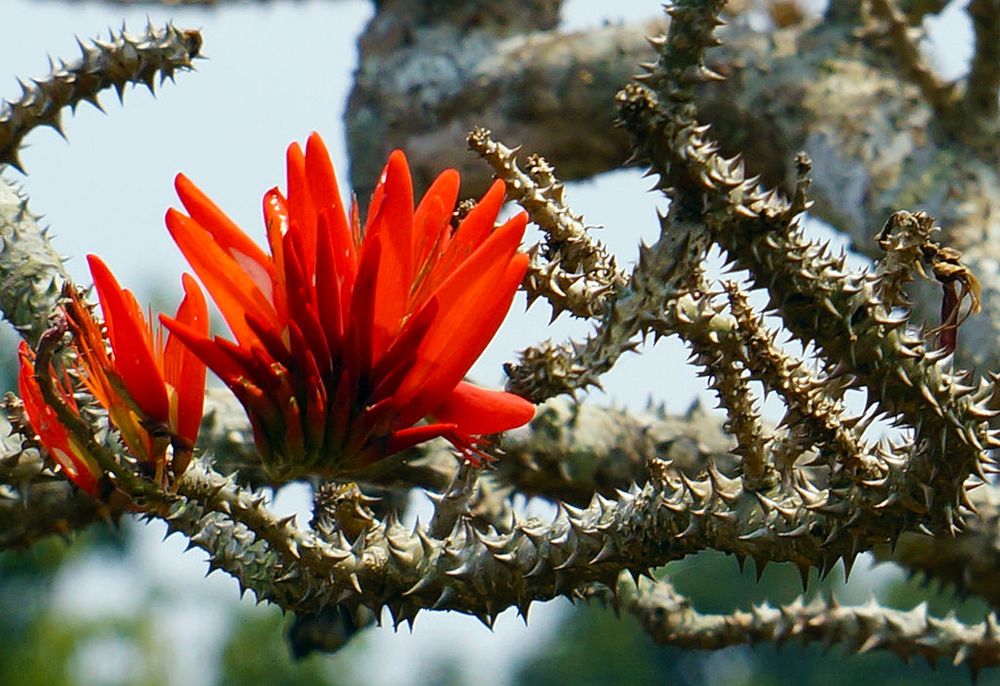
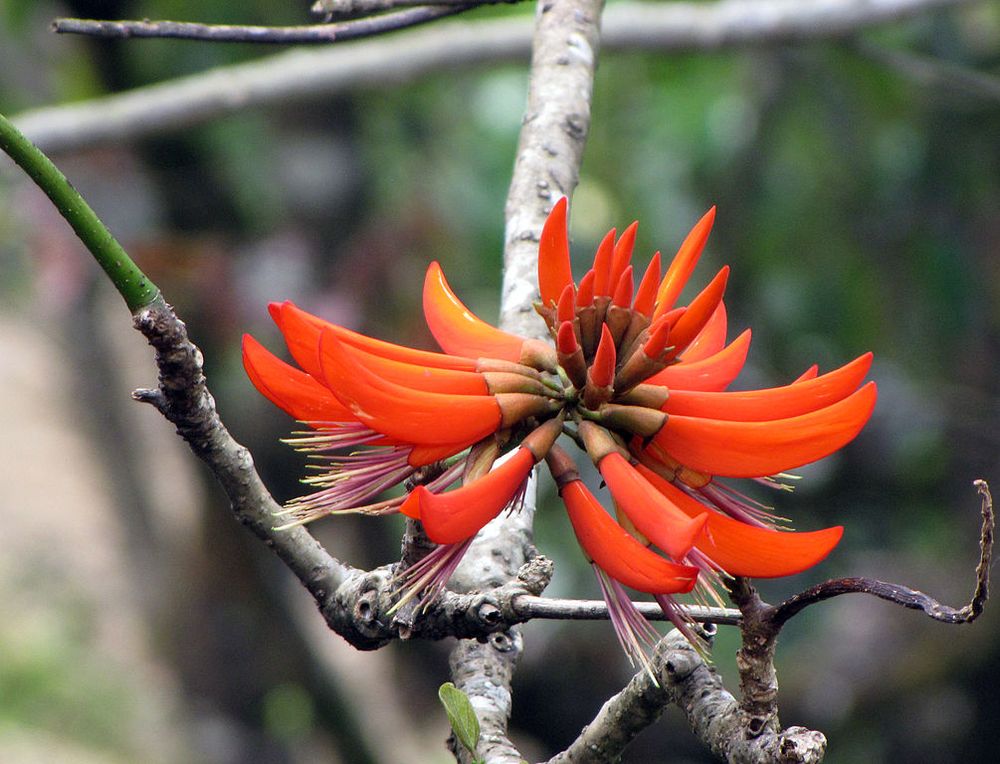
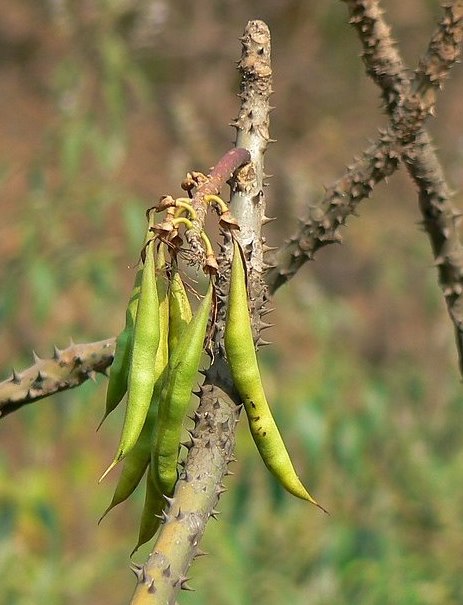
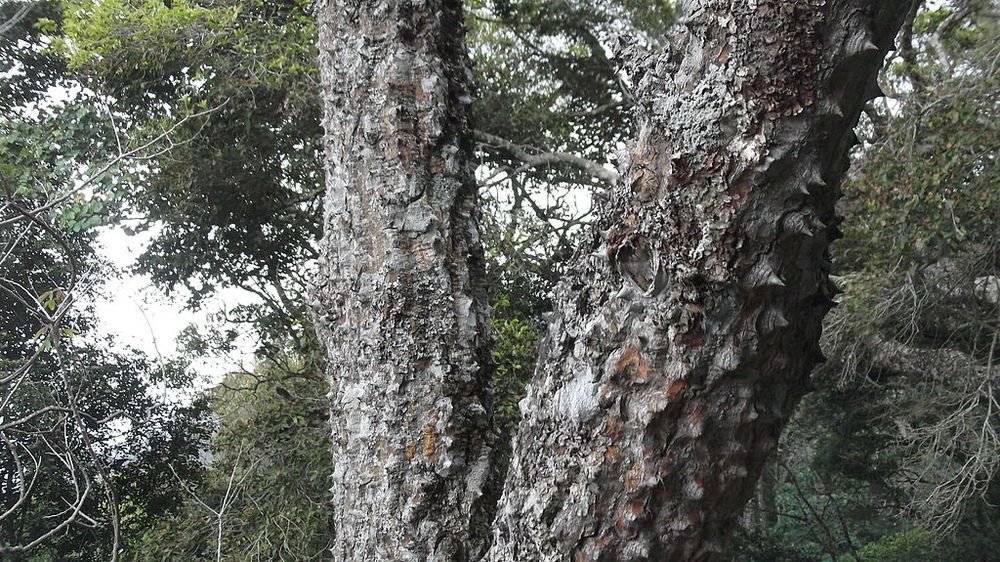
This tropical Asian tree is squat and tortuous; it has trifoliated leaves that fall in the cool season. The beautiful, brilliant red flowers bloom at the end of bare branches, the floral bunches resembling claws, and when they open, a long tuft of stamens emerges. The branches are often covered with thorns and it is said that in Buddhist hell the sinners must climb them. In India, it is one of the five trees of Paradise which grants all wishes, its flowers are offered to the Indian gods, Shiva and Hanuman.
In Laos, the young leaves are eaten as vegetables. In traditional medicine, thong ban has hypnotic properties, it is a strong purgative, a diuretic (bark), it can fight snake bites (seeds), and it relieves painful joints (the leaves). As for the Traditional Medicine Research Centre, it recommends baths made with leaves and roots to reduce swelling.
But this tree belongs to the history of Laos. In fact, in the XIII and XIV centuries, Luang Prabang was called Xieng Dong Xieng Thong, literally translated: “Town of the Dong (a river), town of the Flame Tree”. But, to us, this translation seems somewhat incorrect, because the actual name of the Flame tree is fang, also because the Flame Tree is a tree from Madagascar and it is quite unlikely that it was introduced to Laos before the XIII century. The flamboyance of the Tiger Claw Tree (and that of ton tiane, Butea manosperma, with which it is sometimes confused) no doubt explains this error.
Cet arbre d’Asie tropicale est trapu et tortueux; il a des feuilles trifoliées qui tombent à la saison fraîche. Les fleurs sortent en bout des branches dénudées et sont d’un beau rouge brillant, les boutons floraux ressemblent à des griffes et laissent échapper en s’ouvrant une longue touffe d’étamines. Les branches sont souvent couvertes d’épines et l’on dit que dans l’enfer bouddhique les pêcheurs doivent y monter. En Inde, il est l’un des cinq arbres du paradis, celui qui exauce tous les vœux, ses fleurs sont offertes à Shiva aussi bien qu’à Hanuman.
Au Laos les jeunes feuilles sont consommées comme légumes. En médecine traditionnelle thong ban a des propriété hypnotique, purgative énergique, diurétique (écorce), il peut combattre les morsures de serpents (graines), il soulage les douleurs articulaires (feuilles). L’IMT, quant à lui, recommande des bains de feuilles et de racines pour résorber les enflures.
Mais cet arbre appartient à l’histoire du Laos. En effet Louang Prabang s’est appelée aux XIII° et XIV° siècles Xieng Dong Xieng Thong, traduit unanimement par « ville du Dong (une rivière) ville du flamboyant »; or cette traduction nous semble incorrecte d’une part parce que le nom actuel du flamboyant est fang, d’autre part parce que le flamboyant est un arbre de Madagascar et qu’il est peu probable qu’il ait déjà été introduit au Laos au XIII° siècle. La « flamboyance » de la floraison de cet arbre (et de celle de ton tiane, Butea manosperma, avec lequel il est parfois confondu) explique sans doute cette erreur.










This tropical Asian tree is squat and tortuous; it has trifoliated leaves that fall in the cool season. The beautiful, brilliant red flowers bloom at the end of bare branches, the floral bunches resembling claws, and when they open, a long tuft of stamens emerges. The branches are often covered with thorns and it is said that in Buddhist hell the sinners must climb them. In India, it is one of the five trees of Paradise which grants all wishes, its flowers are offered to the Indian gods, Shiva and Hanuman.
In Laos, the young leaves are eaten as vegetables. In traditional medicine, thong ban has hypnotic properties, it is a strong purgative, a diuretic (bark), it can fight snake bites (seeds), and it relieves painful joints (the leaves). As for the Traditional Medicine Research Centre, it recommends baths made with leaves and roots to reduce swelling.
But this tree belongs to the history of Laos. In fact, in the XIII and XIV centuries, Luang Prabang was called Xieng Dong Xieng Thong, literally translated: “Town of the Dong (a river), town of the Flame Tree”. But, to us, this translation seems somewhat incorrect, because the actual name of the Flame tree is fang, also because the Flame Tree is a tree from Madagascar and it is quite unlikely that it was introduced to Laos before the XIII century. The flamboyance of the Tiger Claw Tree (and that of ton tiane, Butea manosperma, with which it is sometimes confused) no doubt explains this error.
Cet arbre d’Asie tropicale est trapu et tortueux; il a des feuilles trifoliées qui tombent à la saison fraîche. Les fleurs sortent en bout des branches dénudées et sont d’un beau rouge brillant, les boutons floraux ressemblent à des griffes et laissent échapper en s’ouvrant une longue touffe d’étamines. Les branches sont souvent couvertes d’épines et l’on dit que dans l’enfer bouddhique les pêcheurs doivent y monter. En Inde, il est l’un des cinq arbres du paradis, celui qui exauce tous les vœux, ses fleurs sont offertes à Shiva aussi bien qu’à Hanuman.
Au Laos les jeunes feuilles sont consommées comme légumes. En médecine traditionnelle thong ban a des propriété hypnotique, purgative énergique, diurétique (écorce), il peut combattre les morsures de serpents (graines), il soulage les douleurs articulaires (feuilles). L’IMT, quant à lui, recommande des bains de feuilles et de racines pour résorber les enflures.
Mais cet arbre appartient à l’histoire du Laos. En effet Louang Prabang s’est appelée aux XIII° et XIV° siècles Xieng Dong Xieng Thong, traduit unanimement par « ville du Dong (une rivière) ville du flamboyant »; or cette traduction nous semble incorrecte d’une part parce que le nom actuel du flamboyant est fang, d’autre part parce que le flamboyant est un arbre de Madagascar et qu’il est peu probable qu’il ait déjà été introduit au Laos au XIII° siècle. La « flamboyance » de la floraison de cet arbre (et de celle de ton tiane, Butea manosperma, avec lequel il est parfois confondu) explique sans doute cette erreur.


